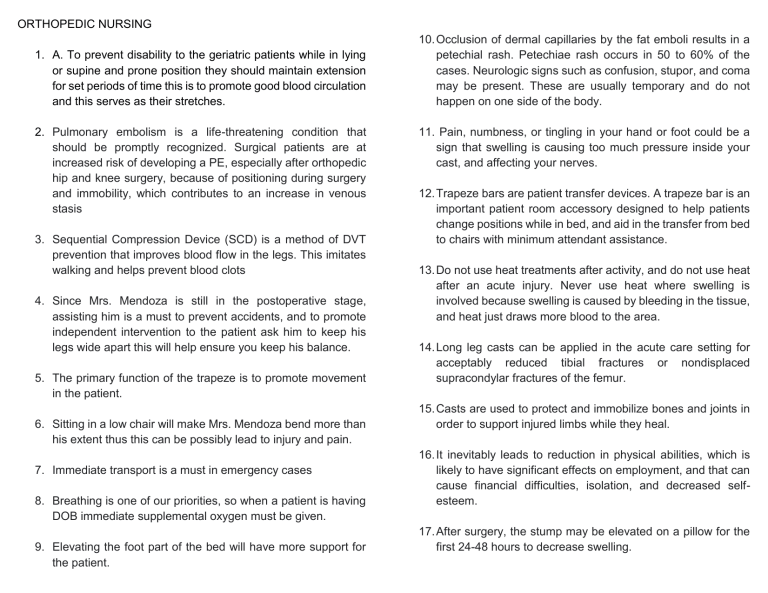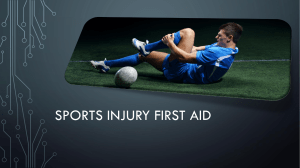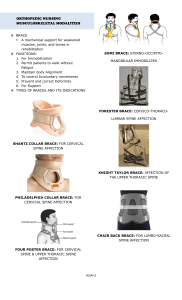
ORTHOPEDIC NURSING 1. A. To prevent disability to the geriatric patients while in lying or supine and prone position they should maintain extension for set periods of time this is to promote good blood circulation and this serves as their stretches. 2. Pulmonary embolism is a life-threatening condition that should be promptly recognized. Surgical patients are at increased risk of developing a PE, especially after orthopedic hip and knee surgery, because of positioning during surgery and immobility, which contributes to an increase in venous stasis 3. Sequential Compression Device (SCD) is a method of DVT prevention that improves blood flow in the legs. This imitates walking and helps prevent blood clots 4. Since Mrs. Mendoza is still in the postoperative stage, assisting him is a must to prevent accidents, and to promote independent intervention to the patient ask him to keep his legs wide apart this will help ensure you keep his balance. 5. The primary function of the trapeze is to promote movement in the patient. 6. Sitting in a low chair will make Mrs. Mendoza bend more than his extent thus this can be possibly lead to injury and pain. 7. Immediate transport is a must in emergency cases 8. Breathing is one of our priorities, so when a patient is having DOB immediate supplemental oxygen must be given. 9. Elevating the foot part of the bed will have more support for the patient. 10. Occlusion of dermal capillaries by the fat emboli results in a petechial rash. Petechiae rash occurs in 50 to 60% of the cases. Neurologic signs such as confusion, stupor, and coma may be present. These are usually temporary and do not happen on one side of the body. 11. Pain, numbness, or tingling in your hand or foot could be a sign that swelling is causing too much pressure inside your cast, and affecting your nerves. 12. Trapeze bars are patient transfer devices. A trapeze bar is an important patient room accessory designed to help patients change positions while in bed, and aid in the transfer from bed to chairs with minimum attendant assistance. 13. Do not use heat treatments after activity, and do not use heat after an acute injury. Never use heat where swelling is involved because swelling is caused by bleeding in the tissue, and heat just draws more blood to the area. 14. Long leg casts can be applied in the acute care setting for acceptably reduced tibial fractures or nondisplaced supracondylar fractures of the femur. 15. Casts are used to protect and immobilize bones and joints in order to support injured limbs while they heal. 16. It inevitably leads to reduction in physical abilities, which is likely to have significant effects on employment, and that can cause financial difficulties, isolation, and decreased selfesteem. 17. After surgery, the stump may be elevated on a pillow for the first 24-48 hours to decrease swelling. 18. Phantom pain is pain that feels like it's coming from a body part that's no longer there. Doctors once believed this postamputation phenomenon was a psychological problem, but experts now recognize that these real sensations originate in the spinal cord and brain. 19. It is important to avoid brisk rubbing which may irritate the skin. Lotions, creams, and moisturizers should not be applied also to the limb unless specific orders are given by. 20. Phantom pain results from a mix-up in nervous system signals, specifically between the spinal cord and brain. When a body part is amputated, the nerve connections from the periphery to the brain remain in place. 21. D - To prevent pressure injuries, the client must change body position. 22. C - The complications of immobility include skin breakdown, pressure ulcers, contractures, muscular weakness, and muscular atrophy; turning client every 2 hours and massaging bony prominences prevent these complications 23. B - A cast requires approximately 24 to 72 hours to dry, and until dry, it does not have full strength. While drying, the cast should not be placed on a hard surface. The initial cooling occurs in about 15 minutes after application of the cast. 24. D - To avoid damage to the nerves and blood vessels in your armpits, your weight should rest on your hands, not on the underarm supports. 25. D - Soften rough edges by placing 1-inch strips of adhesive tape or moleskin or the rough patch after the cast is completely dry. Taping the cast as soon as possible prevents skin damage. 26. D - A classic sign of scoliosis is asymmetrical dress or skirt hem caused by unevenness of affected shoulder and hip, due to a lateral curvature of the spine. The spinal deformity causes the asymmetry. 27. C - Severe scoliosis may have a significant effect on respiratory function. The effect is most often restrictive due to severe anatomical distortion of the chest, leading to reduced lung volumes, limited diaphragmatic excursion and chest wall muscle inefficiency. 28. A - The client may have coldness of the extremity due to decreased blood flow. 29. B - Cast should hold a broken bone in place as it heals. It also helps to prevent or decrease muscle contractions, and are effective at providing immobilization 30. C - The layer after the stockinette is sheet wadding. It is applied from the distal end of the injured extremity to the proximal end with smooth and even application. 31. C- It is used to keep the thigh bone (femur) and pelvis still and this promotes immobilization. 32. B-Ensure that the traction weight bag is hanging freely, the bag must not rest on the bed or the floor, this promotes balance in the traction so that the therapy would be effective in immobilizing 33. D-An intramedullary nail is a metal rod that is inserted into the medullary cavity of a bone and across the fracture in order to provide a solid support for the fractured bone. Intramedullary nailing is currently considered the "gold standard" for treatment of femoral shaft fractures 34. C-Bone infection is most often caused by bacteria. 35. C36. A-1,2,and 3 are the right answer except the 4 which are cleaning the wound from the periphery. Cleaning a wound should be from the center of the wound outward towards the periwound skin margins. 45. A. The lateral decubitus position provides surgical exposure to the chest, retroperitoneum, hip, and lateral leg. Common procedures performed in this position include procedures on the lung, aorta, kidney, and hip. 46. C. 500cc/24hrs = 20 micro gtts/min 47. C. 1gm/750g x 6ml = 8ml 37. B-Open fracture (compound fracture): The bone pokes through the skin and can be seen. Or a deep wound exposes the bone through the skin 48. A. 4 diagonal bars is not included in this. 49. D. the counter traction is the weight of the patient. 38. C-fracture healing may be delayed because of excessive motion of fracture fragments or synovial fluid collagenases that weaken the fracture callus. 39. D-quadriceps femoris are among the largest and strongest muscles in your body that 40. C-sternum is a T-shaped flat bone that's located in the middle of your chests 41. C. sternum, Your axial skeleton is made up of the 80 bones within the central core of your body. This includes bones in your head, neck, back and chest. Your axial skeleton protects and cushions your brain, spinal cord and organs. 42. C. use of a high seated chair prevents pressure onto the hips 43. C. lengthening of the leg, this does not cause dislocation of the prosthesis. 44. B. assess skin color and pedal pulse, The 6 P's of a neurovascular assessment are pain, poikilothermia, paresthesia, paralysis, pulselessness, and pallor. 50. A. 9lbs half of 18lbs ordered by the doctor.




